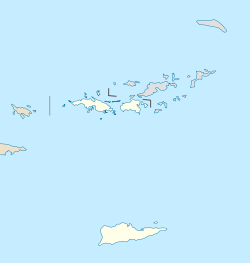Skytsborg | |
 | |
| Location | Charlotte Amalie, U.S. Virgin Islands |
|---|---|
| Coordinates | 18°20′37.83″N64°55′46.53″W / 18.3438417°N 64.9295917°W |
| Built | 1679 |
| NRHP reference No. | 91001844 [1] |
| Significant dates | |
| Added to NRHP | December 20, 1991 |
| Designated NHL | October 12, 1994 [2] |
Blackbeard's Castle is one of five National Historic Landmarks in the U.S. Virgin Islands. It is located in the city of Charlotte Amalie, on the island of St. Thomas. Erected in 1679 by the Danes as a watchtower to protect the harbor as well as Fort Christian, Blackbeard's Castle was originally called Skytsborg (meaning protection castle). It is located at the highest point of Government Hill. Skytsborg served as a very effective vantage point for Danish soldiers to spot enemy ships. Fort Christian is at sea level, thus making it ideal for thwarting attackers with cannon fire; however, the fort itself did not provide an ideal view of incoming ships entering the harbor.
Contents
It was the centerpiece of a private residence for many years, and was turned into a hotel, but is no longer open to the public.


